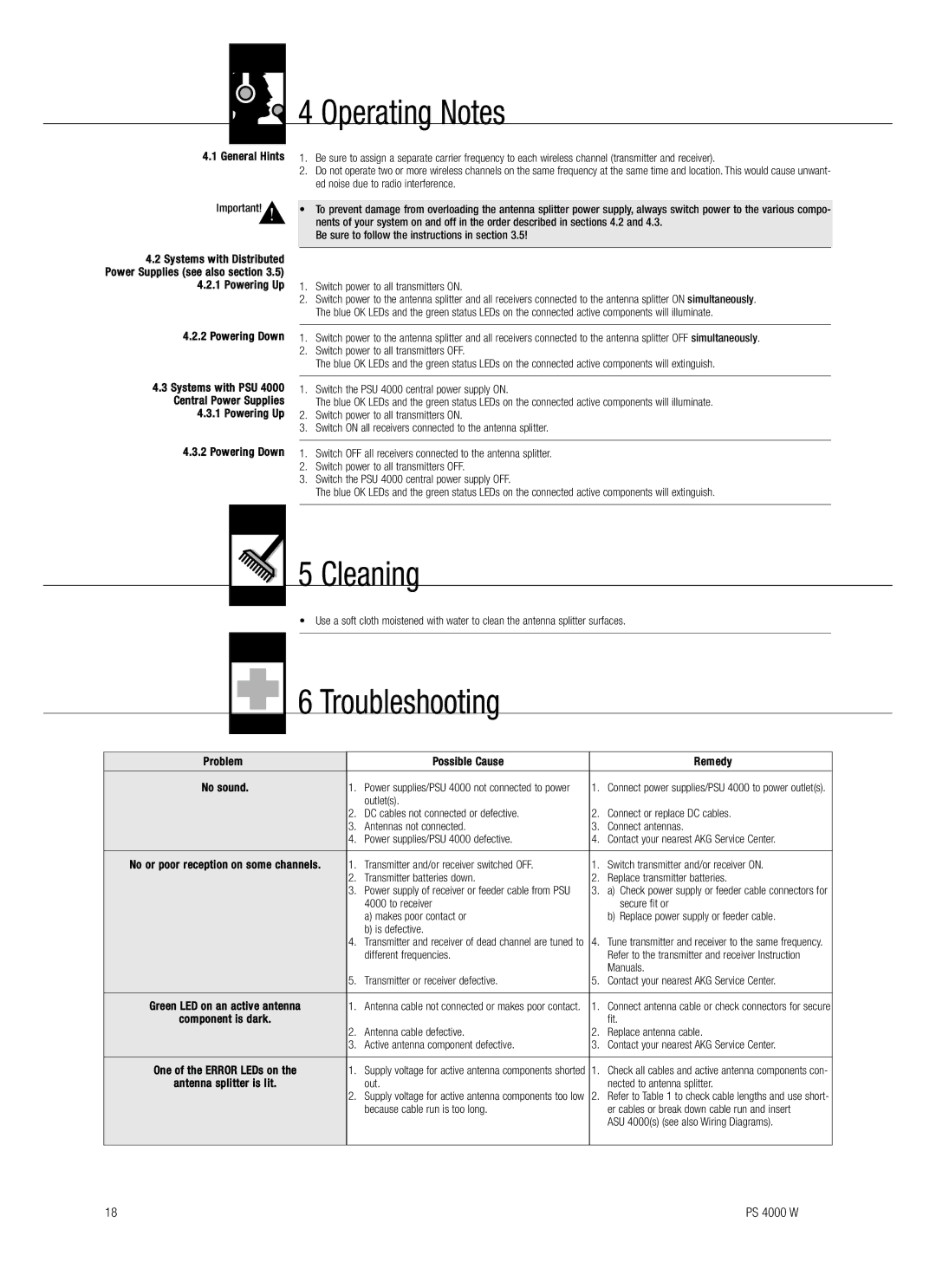

 4 Operating Notes
4 Operating Notes
4.1 General Hints
Important!▲!
4.2Systems with Distributed Power Supplies (see also section 3.5)
4.2.1Powering Up
1.Be sure to assign a separate carrier frequency to each wireless channel (transmitter and receiver).
2.Do not operate two or more wireless channels on the same frequency at the same time and location. This would cause unwant- ed noise due to radio interference.
•To prevent damage from overloading the antenna splitter power supply, always switch power to the various compo - nents of your system on and off in the order described in sections 4.2 and 4.3.
Be sure to follow the instructions in section 3.5!
1.Switch power to all transmitters ON.
2.Switch power to the antenna splitter and all receivers connected to the antenna splitter ON simultaneously. The blue OK LEDs and the green status LEDs on the connected active components will illuminate.
4.2.2 Powering Down 1. Switch power to the antenna splitter and all receivers connected to the antenna splitter OFF simultaneously.
2.Switch power to all transmitters OFF.
The blue OK LEDs and the green status LEDs on the connected active components will extinguish.
4.3Systems with PSU 4000 Central Power Supplies
4.3.1Powering Up
4.3.2Powering Down
1.Switch the PSU 4000 central power supply ON.
The blue OK LEDs and the green status LEDs on the connected active components will illuminate.
2.Switch power to all transmitters ON.
3.Switch ON all receivers connected to the antenna splitter.
1.Switch OFF all receivers connected to the antenna splitter.
2.Switch power to all transmitters OFF.
3.Switch the PSU 4000 central power supply OFF.
The blue OK LEDs and the green status LEDs on the connected active components will extinguish.
 5 Cleaning
5 Cleaning
• Use a soft cloth moistened with water to clean the antenna splitter surfaces.
 6 Troubleshooting
6 Troubleshooting
Problem |
| Possible Cause |
| Remedy |
No sound. | 1. | Power supplies/PSU 4000 not connected to power | 1. | Connect power supplies/PSU 4000 to power outlet(s). |
|
| outlet(s). |
|
|
| 2. | DC cables not connected or defective. | 2. | Connect or replace DC cables. |
| 3. | Antennas not connected. | 3. | Connect antennas. |
| 4. | Power supplies/PSU 4000 defective. | 4. | Contact your nearest AKG Service Center. |
|
|
|
|
|
No or poor reception on some channels. | 1. | Transmitter and/or receiver switched OFF. | 1. | Switch transmitter and/or receiver ON. |
| 2. | Transmitter batteries down. | 2. | Replace transmitter batteries. |
| 3. | Power supply of receiver or feeder cable from PSU | 3. | a) Check power supply or feeder cable connectors for |
|
| 4000 to receiver |
| secure fit or |
|
| a) makes poor contact or |
| b) Replace power supply or feeder cable. |
|
| b) is defective. |
|
|
| 4. | Transmitter and receiver of dead channel are tuned to | 4. | Tune transmitter and receiver to the same frequency. |
|
| different frequencies. |
| Refer to the transmitter and receiver Instruction |
|
|
|
| Manuals. |
| 5. | Transmitter or receiver defective. | 5. | Contact your nearest AKG Service Center. |
|
|
|
|
|
Green LED on an active antenna | 1. | Antenna cable not connected or makes poor contact. | 1. | Connect antenna cable or check connectors for secure |
component is dark. |
|
|
| fit. |
| 2. | Antenna cable defective. | 2. | Replace antenna cable. |
| 3. | Active antenna component defective. | 3. | Contact your nearest AKG Service Center. |
|
|
|
|
|
One of the ERROR LEDs on the | 1. | Supply voltage for active antenna components shorted | 1. | Check all cables and active antenna components con - |
antenna splitter is lit. |
| out. |
| nected to antenna splitter. |
| 2. | Supply voltage for active antenna components too low | 2. | Refer to Table 1 to check cable lengths and use short - |
|
| because cable run is too long. |
| er cables or break down cable run and insert |
|
|
|
| ASU 4000(s) (see also Wiring Diagrams). |
|
|
|
|
|
18 | PS 4000 W |
